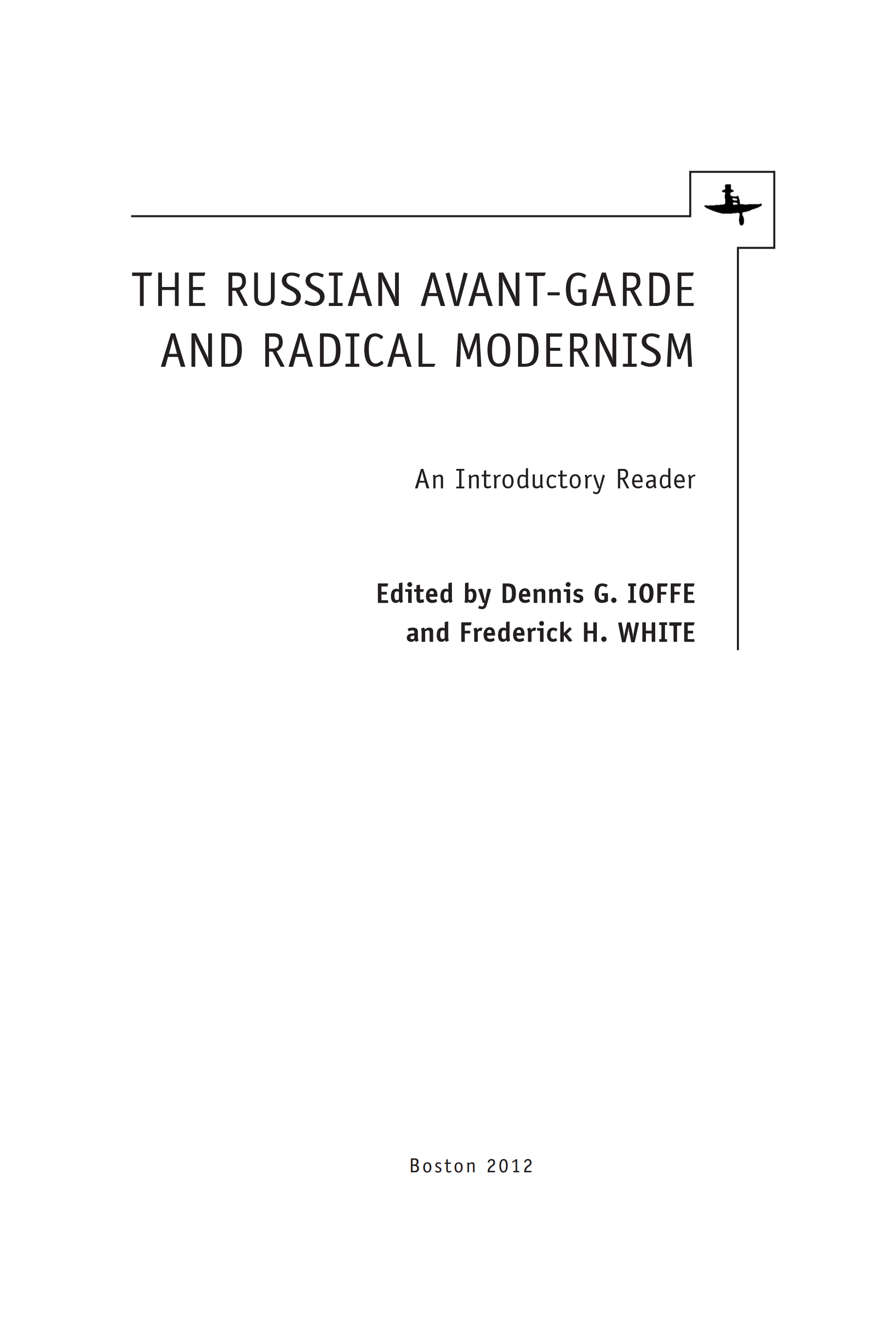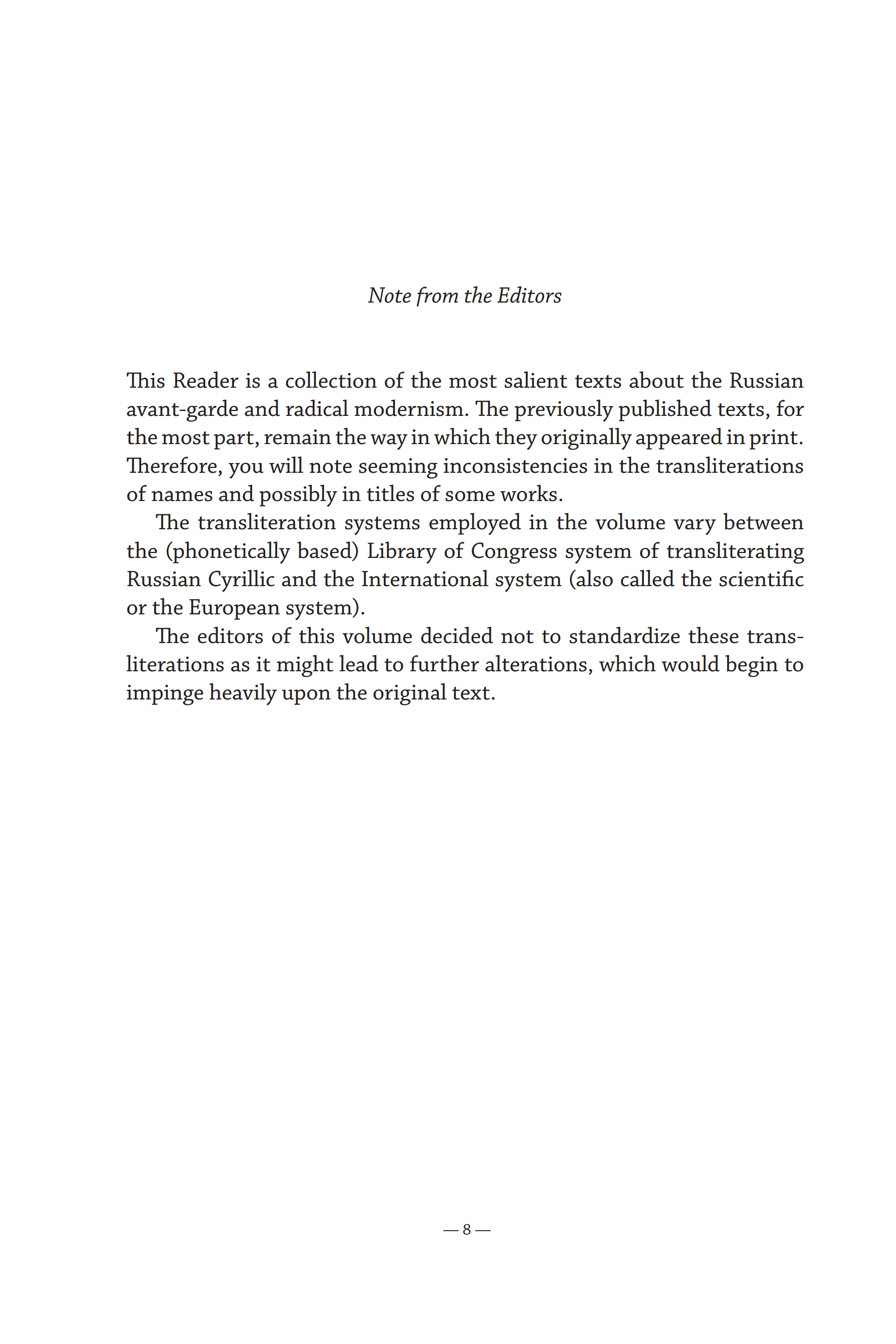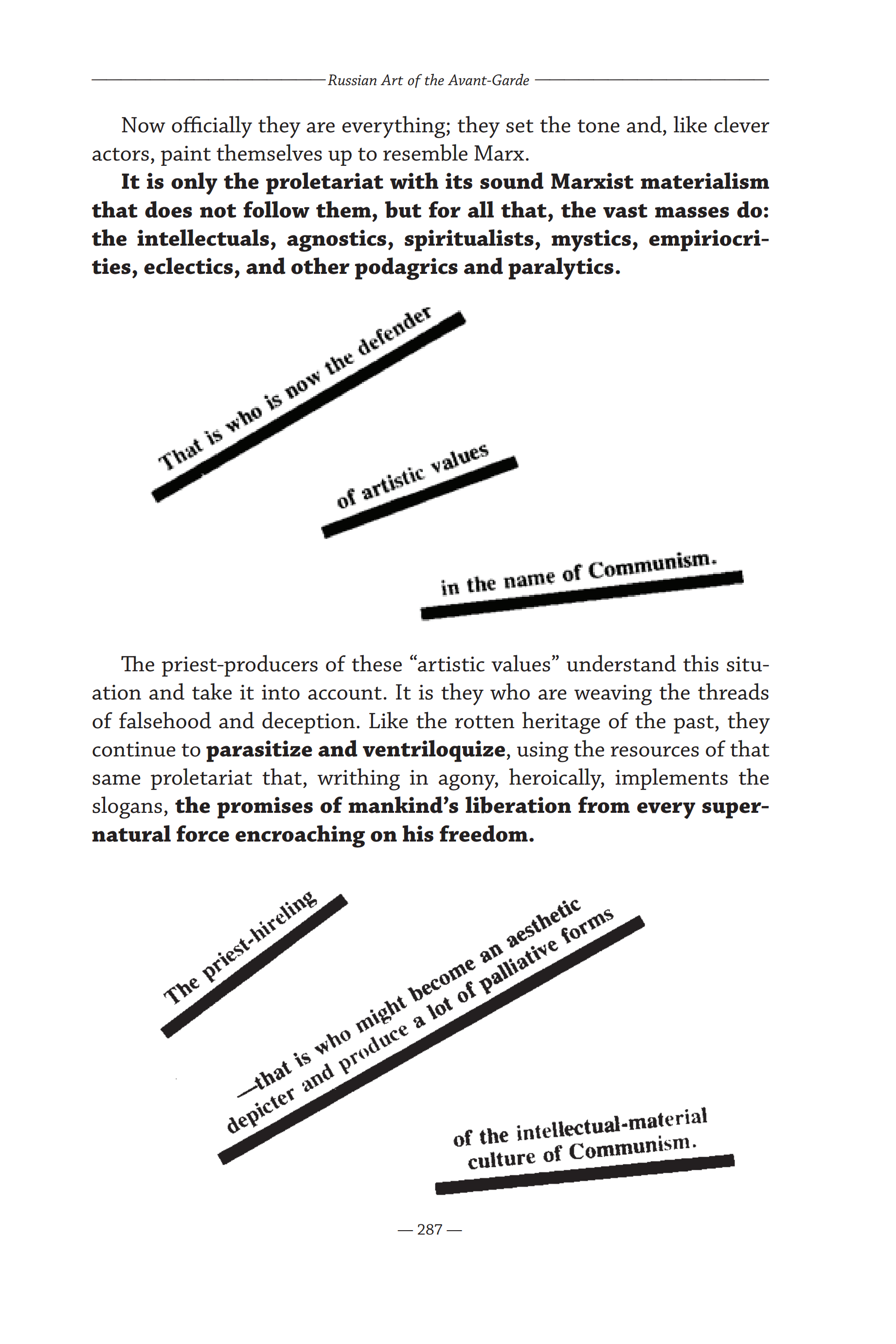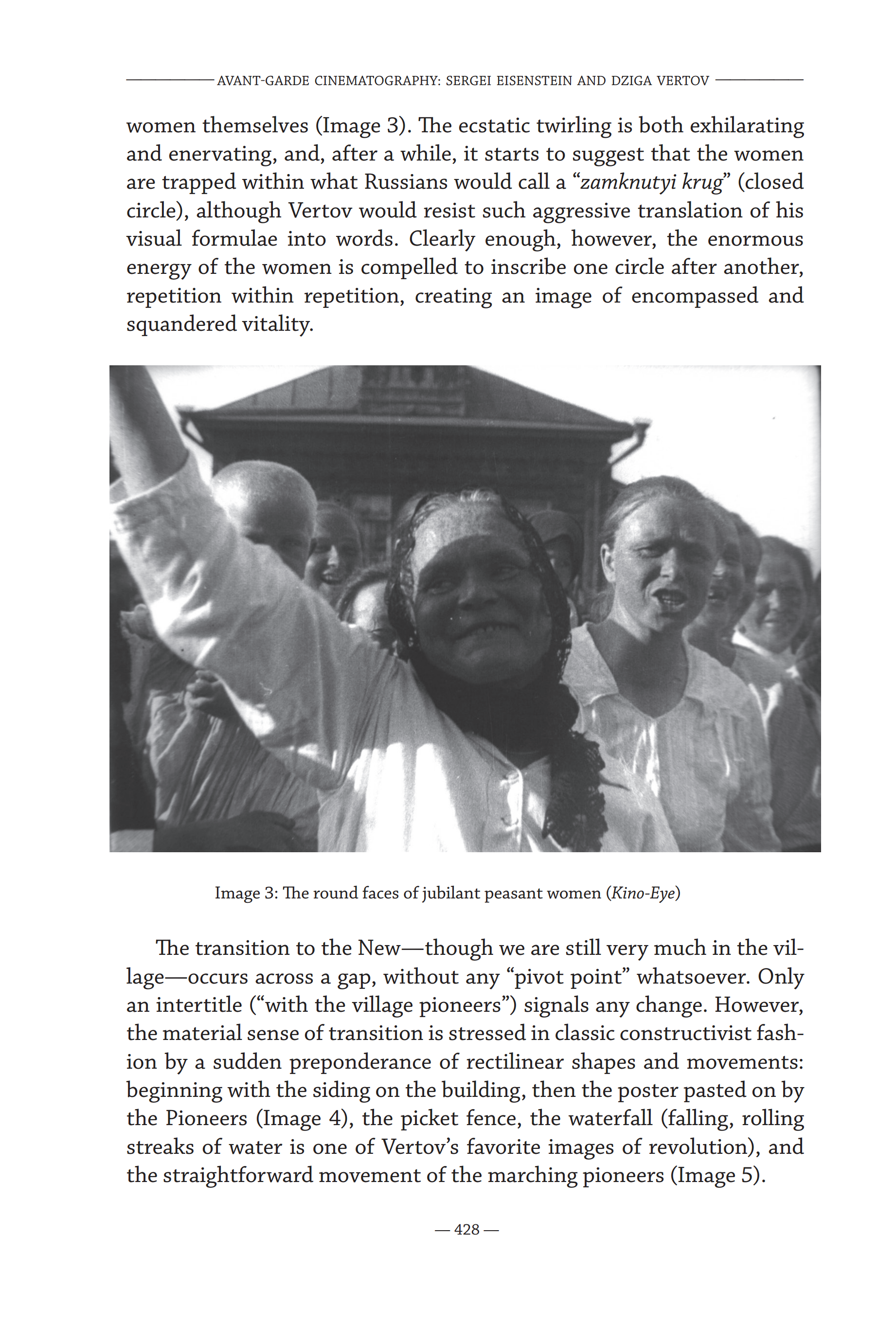|
|
The Russian Avant-Garde and Radical Modernism : An Introductory Reader. — Boston, 2012  The Russian Avant-Garde and Radical Modernism : An Introductory Reader / Edited by Dennis G. Ioffe and Frederick H. White. — Boston : Academic Studies Press, 2012. — 486 p., ill. — (Cultural Syllabus ; Series Editor: Mark Lipovetsky, University of Colorado - Boulder). — ISBN 978-1-936235-29-2 (hardback). — ISBN 978-1-936235-45-2 (paperback)
This volume is intended for a student audience and aims at providing a general overview of the main currents that constituted the final stage of the modernist creative history—the Russian avant-garde described from a historical perspective. The collection features a number of original contributions commissioned specifically for the resent volume along with some scholarly classics devoted to the relevant topics. The texts presented in this reader were selected with the aim of bringing the most suitable and accessible information on the issues in question. They reflect both a high caliber of scholarly rigor and professional substantiality along with an overall accessibility for students.
Contents
List of Illustrations 7
Note from the Editors 8
I. An Introduction to the Russian Avant-Garde and Radical Modernism by Dennis Ioffe and Frederick H. White 9
II. Russian Futurism and the Related Currents
1. Hylaea by Vladimir Markov 21
1a) Velimir Khlebnikov: A “Timid” Futurist by Willem G. Weststeijn 54
1b) Mayakovsky as Literary Critic by Willem G. Weststeijn 70
2. Russian Art of the Avant-Garde: Translated Texts: John E. Bowlt 85
Content and Form, 1910 — VASILII KANDINSKY 85
Preface to Catalogue of One-Man Exhibition, 1913 — NATALYA GONCHAROVA 89
Cubism (Surface-Plane), 1912 — DAVID BURLIUK 93
Cubism, I912 — NATALYA GONCHAROVA 101
Why We Paint Ourselves: A Futurist Manifesto, 1913 — ILYA ZDANEVICH and MIKHAIL LARIONOV 102
Rayonists and Futurists. A Manifesto, 1913 — MIKHAIL LARIONOV and NATALYA GONCHAROVA 105
Rayonist Painting, 1913 — MIKHAIL LARIONOV 109
Pictorial Rayonism, 1914 — MIKHAIL LARIONOV 118
From Cubism and Futurism to Suprematism: The New Painterly Realism, 1915 — KAZIMIR MALEVICH 120
Suprematism in World Reconstruction, 1920 — EL LISSITZKY 140
Program Declaration, 1919 — KOMFUT 147
3. The Phenomenon of David Burliuk in the History of the Russian Avant-Garde Movement by Elena Basner 150
4. The Revolutionary Art of Natalia Goncharova and Mikhail Larionov by Jane A. Sharp 170
III. Russian Suprematism and Constructivism
1. Kazimir Malevich: His Creative Path by Evgenii Kovtun 206
2. Constructivism and Productivism in the 1920s by Christina Lodder 227
3. The Birth of Socialist Realism from the Spirit of the Russian Avant-Garde by Boris Groys 250
4. Russian Art of the Avant-Garde: Translated Texts: John E. Bowlt 277
The Paths of Proletarian Creation, 1920 — ALEKSANDR BOGDANOV 277
Declaration: Comrades, Organizers of Life, 1923 — LEF 281
Constructivism [Extracts], 1922 — ALEKSEI GAN 284
IV. The OBERIU Circle (Daniil Kharms and His Associates)
1. OBERIU: Daniil Kharms and Aleksandr Vvedensky on/in Time and History by Evgeny Pavlov 296
2. Some Philosophical Positions in Some “OBERIU” Texts (Translator’s preface) by Eugene Ostashevsky 314
V. Russian Experimental Performance and Theater
1. Vsevolod Meyerhold by Alexander Burry 357
2. The Culture of Experiment in Russian Theatrical Modernism: the OBERIU Theater and the Biomechanics of Vsevolod Meyerhold by Michael Klebanov 385
VI. Avant-Garde Cinematography: Sergei Eisenstein and Dziga Vertov
1. Eisenstein: A Short Biography by Frederick H. White 407
2. Allegory and Accommodation: Vertov’s Three Songs of Lenin (1934) as a Stalinist Film by John MacKay 420
Concluding Addendum: The Tradition of Experimentation in Russian Culture and the Russian Avant-Garde by Dennis Ioffe 454
List of Contributors 468
Bibliography 472
Note from the Editors
This Reader is a collection of the most salient texts about the Russian avant-garde and radical modernism. The previously published texts, for the most part, remain the way in which they originally appeared in print. Therefore, you will note seeming inconsistencies in the transliterations of names and possibly in titles of some works.
The transliteration systems employed in the volume vary between the (phonetically based) Library of Congress system of transliterating Russian Cyrillic and the International system (also called the scientific or the European system).
The editors of this volume decided not to standardize these transliterations as it might lead to further alterations, which would begin to impinge heavily upon the original text.
Sample pages 
Direct download link (pdf; 6.4 MB)
The electronic version of this edition is published only for scientific, educational or cultural purposes under the terms of fair use. Any commercial use is prohibited. If you have any claims about copyright, please send a letter to 42@tehne.com.
30 июня 2016, 19:41
0 комментариев
|
Партнёры
|






Комментарии
Добавить комментарий